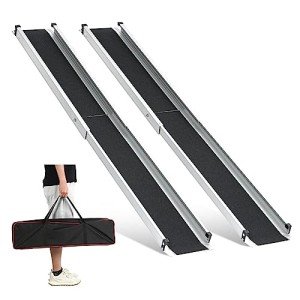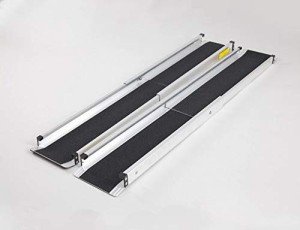Telescopic ramps have carved a niche in various fields, serving as essential tools for facilitating easy transitions between different elevations. The 152 cm pair of telescopic ramps stands as an exemplary model, offering a blend of convenience, durability, and versatility. This guide endeavors to elucidate the features, benefits, applications, and considerations concerning telescopic ramps while also answering frequently posed questions.
What Are Telescopic Ramps?
Telescopic ramps are adjustable ramps designed to provide an incline for wheelchair users, pedestrians, or vehicles needing assistance to traverse spaces such as curbs, stairs, or uneven surfaces. These ramps are particularly favored because they are lightweight, portable, and allow for adjustable lengths, thus accommodating a variety of needs.
Key Features of Telescopic Ramps 152 cm Pair
When considering a 152 cm telescopic ramp pair, several distinct features stand out:
-
Adjustable Length: Designed for adaptability, these ramps can be extended or shortened based on the specific height requirement, making them suitable for diverse uses.
-
Lightweight Construction: Typically made from materials such as aluminum or heavy-duty plastic, these ramps are easy to transport and maneuver.
-
High Weight Capacity: A good pair of telescopic ramps can often support substantial weight, making them suitable for various applications ranging from mobility aids to vehicles.
-
Slip-Resistant Surface: Safety remains paramount, and the ramps are often equipped with textured surfaces to reduce the chances of slipping.
-
Portable Design: Many telescopic ramps come with built-in handles or are foldable, further enhancing their portability for users on the go.
Benefits of Using Telescopic Ramps
The relevance of telescopic ramps extends across many sectors, and they come with several benefits:
-
Accessibility: Telecpiscopic ramps play a crucial role in making spaces more accessible to individuals with mobility challenges, allowing them to navigate different terrains comfortably.
-
Versatility: Whether for individuals needing wheelchair access or for loading and unloading items from a vehicle, these ramps are adaptable to a range of scenarios.
-
Cost-Effectiveness: Investing in a pair of telescopic ramps can often be more economical than constructing permanent ramps.
-
Ease of Storage: Due to their collapsible design, these ramps can be easily stored when not in use, freeing up valuable space.
Applications of Telescopic Ramps
The scope of telescopic ramp usage is broad and diverse, with applications ranging from personal to commercial usage:
-
Personal Mobility: Many individuals use telescopic ramps to assist in wheelchair access to vehicles or through home orientation.
-
Commercial Use: In warehouses or distribution centers, these ramps facilitate easy access for forklifts or hand trucks when loading or unloading goods.
-
Event Accessibility: Event organizers can utilize telescopic ramps to ensure venues are accessible for individuals with disabilities.
-
Recovery and Towing: Telescopic ramps are often employed in recovery operations for unloading vehicles that have broken down.
Considerations When Selecting Telescopic Ramps
When choosing the right pair of telescopic ramps, there are several factors to keep in mind:
-
Weight Capacity: Ensure the ramp you opt for can handle the weight requirements of the intended use.
-
Length and Height Requirement: Assess the specific height that needs to be accommodated to determine the most suitable length.
-
Material: Choose ramps made out of durable materials that are also lightweight for portability.
-
Surface Texture: Consider ramps with a slip-resistant surface to enhance safety during use.
-
Portability Features: Look for ramps that are easy to transport, with handles or a foldable design that fits in your vehicle or storage space.
FAQs
1. How do I determine the correct length of a telescopic ramp?
To determine the correct length, measure the height of the obstacle (curb, step, etc.) you need to traverse. Aim for a gentle slope whenever possible. A good rule of thumb is to use a 1:12 slope ratio, meaning for every inch of height, there should be at least 12 inches of length.
2. Can telescopic ramps support a heavy vehicle?
Yes, many telescopic ramps are designed to support substantial weights, often ranging from a few hundred pounds to over a thousand. Always check the weight capacity specified by the manufacturer before use.
3. Are telescopic ramps safe to use on uneven surfaces?
While telescopic ramps can be used on uneven surfaces, it is vital to ensure that they have a firm and stable foundation. Users should assess the surface and set up the ramp securely to avoid accidents.
4. How do I maintain my telescopic ramps?
Regularly check the ramps for any signs of wear or damage. Clean the surfaces to prevent debris build-up, and ensure the hinges and locking mechanisms function properly.
5. Can I use my telescopic ramps for outdoor activities?
Yes, if the ramps are constructed from weather-resistant materials, they can be used for outdoor activities, but always consider environmental factors such as rain or mud that could affect traction and safety.
Telescopic ramps 152 cm pair serves as an essential tool for enhancing accessibility across a plethora of environments, from personal use to commercial applications. Their adjustable nature, combined with portability and a wide range of features, makes them invaluable in today's mobility landscape. By understanding the key elements associated with these ramps, users can make informed decisions that best suit their unique needs, ensuring safety and convenience in their daily endeavors. Whether for fostering independence for individuals with mobility challenges or assisting with logistical needs, the importance of identifying the right telescopic ramp cannot be understated.






